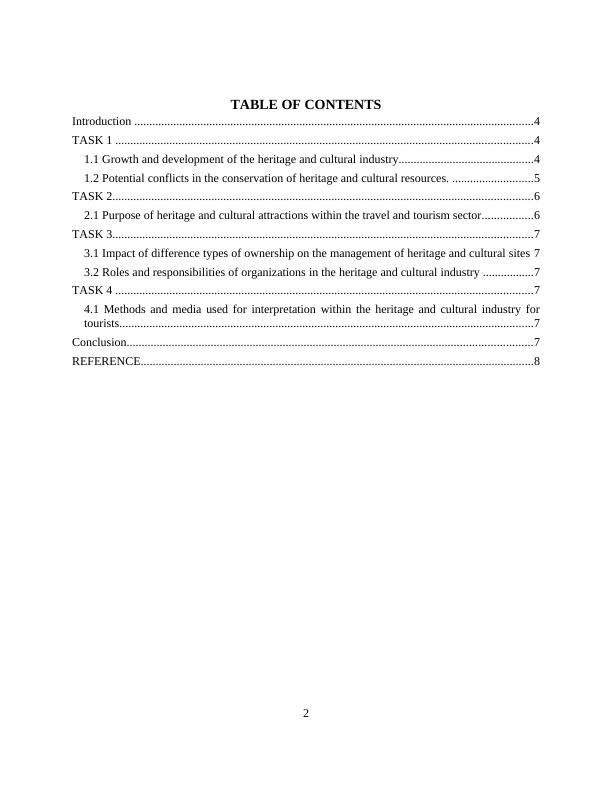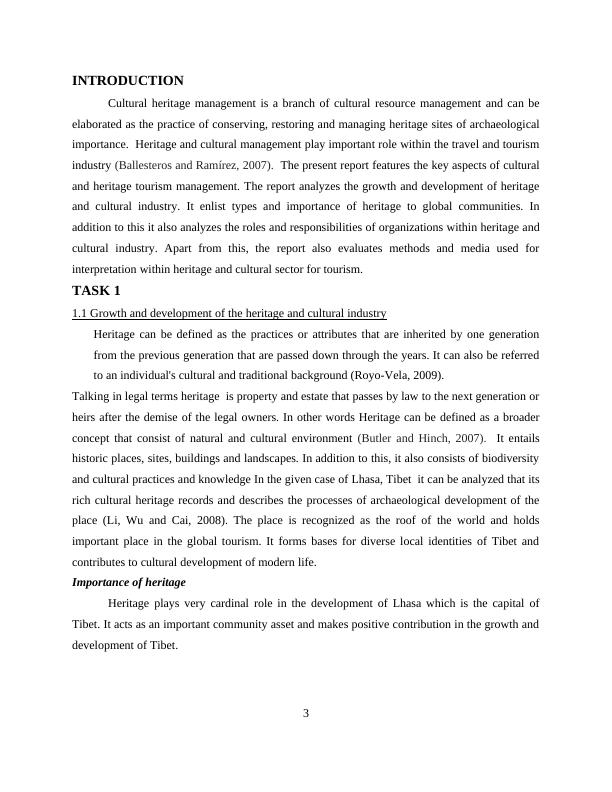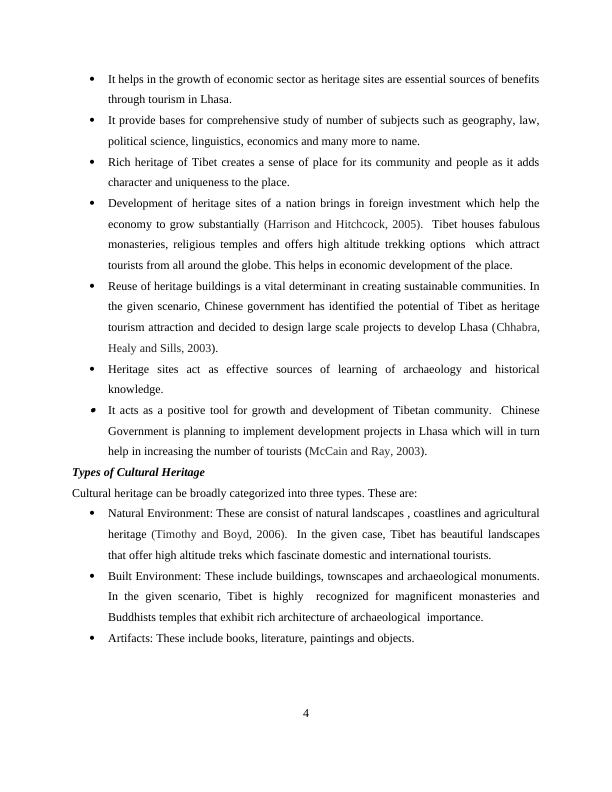Ask a question from expert
(Solved) Heritage and Cultural Tourism Management : Assignment
14 Pages4605 Words244 Views
Added on 2019-12-28
(Solved) Heritage and Cultural Tourism Management : Assignment
Added on 2019-12-28
BookmarkShareRelated Documents
Heritage and Cultural TourismManagement

TABLE OF CONTENTSIntroduction .....................................................................................................................................4TASK 1 ...........................................................................................................................................41.1 Growth and development of the heritage and cultural industry.............................................41.2 Potential conflicts in the conservation of heritage and cultural resources. ...........................5TASK 2............................................................................................................................................62.1 Purpose of heritage and cultural attractions within the travel and tourism sector.................6TASK 3............................................................................................................................................73.1 Impact of difference types of ownership on the management of heritage and cultural sites 73.2 Roles and responsibilities of organizations in the heritage and cultural industry .................7TASK 4 ...........................................................................................................................................74.1 Methods and media used for interpretation within the heritage and cultural industry fortourists..........................................................................................................................................7Conclusion.......................................................................................................................................7REFERENCE...................................................................................................................................82

INTRODUCTION Cultural heritage management is a branch of cultural resource management and can beelaborated as the practice of conserving, restoring and managing heritage sites of archaeologicalimportance. Heritage and cultural management play important role within the travel and tourismindustry (Ballesteros and Ramírez, 2007). The present report features the key aspects of culturaland heritage tourism management. The report analyzes the growth and development of heritageand cultural industry. It enlist types and importance of heritage to global communities. Inaddition to this it also analyzes the roles and responsibilities of organizations within heritage andcultural industry. Apart from this, the report also evaluates methods and media used forinterpretation within heritage and cultural sector for tourism. TASK 1 1.1 Growth and development of the heritage and cultural industryHeritage can be defined as the practices or attributes that are inherited by one generationfrom the previous generation that are passed down through the years. It can also be referredto an individual's cultural and traditional background (Royo-Vela, 2009). Talking in legal terms heritage is property and estate that passes by law to the next generation orheirs after the demise of the legal owners. In other words Heritage can be defined as a broaderconcept that consist of natural and cultural environment (Butler and Hinch, 2007). It entailshistoric places, sites, buildings and landscapes. In addition to this, it also consists of biodiversityand cultural practices and knowledge In the given case of Lhasa, Tibet it can be analyzed that itsrich cultural heritage records and describes the processes of archaeological development of theplace (Li, Wu and Cai, 2008). The place is recognized as the roof of the world and holdsimportant place in the global tourism. It forms bases for diverse local identities of Tibet andcontributes to cultural development of modern life. Importance of heritageHeritage plays very cardinal role in the development of Lhasa which is the capital ofTibet. It acts as an important community asset and makes positive contribution in the growth anddevelopment of Tibet. 3

It helps in the growth of economic sector as heritage sites are essential sources of benefitsthrough tourism in Lhasa. It provide bases for comprehensive study of number of subjects such as geography, law,political science, linguistics, economics and many more to name. Rich heritage of Tibet creates a sense of place for its community and people as it addscharacter and uniqueness to the place. Development of heritage sites of a nation brings in foreign investment which help theeconomy to grow substantially (Harrison and Hitchcock, 2005). Tibet houses fabulousmonasteries, religious temples and offers high altitude trekking options which attracttourists from all around the globe. This helps in economic development of the place. Reuse of heritage buildings is a vital determinant in creating sustainable communities. Inthe given scenario, Chinese government has identified the potential of Tibet as heritagetourism attraction and decided to design large scale projects to develop Lhasa (Chhabra,Healy and Sills, 2003). Heritage sites act as effective sources of learning of archaeology and historicalknowledge.It acts as a positive tool for growth and development of Tibetan community. ChineseGovernment is planning to implement development projects in Lhasa which will in turnhelp in increasing the number of tourists (McCain and Ray, 2003). Types of Cultural HeritageCultural heritage can be broadly categorized into three types. These are: Natural Environment: These are consist of natural landscapes , coastlines and agriculturalheritage (Timothy and Boyd, 2006). In the given case, Tibet has beautiful landscapesthat offer high altitude treks which fascinate domestic and international tourists. Built Environment: These include buildings, townscapes and archaeological monuments.In the given scenario, Tibet is highly recognized for magnificent monasteries andBuddhists temples that exhibit rich architecture of archaeological importance. Artifacts: These include books, literature, paintings and objects. 4

End of preview
Want to access all the pages? Upload your documents or become a member.
Related Documents
Management of heritage and cultural tourism sites in UKlg...
|15
|4149
|409
Heritage & Cultural Tourism Management Assignmentlg...
|16
|4335
|315
Importance of Heritage and Culture in Travel and Tourismlg...
|11
|2975
|180
Heritage and Cultural Tourism Management Assignment (Solved)lg...
|21
|6491
|207
Heritage and Cultural Tourism Assignment Solutionlg...
|23
|7139
|291
Case Study Of Lhasa- Impact Of Different Owners On Managing Tourism Sitelg...
|15
|5235
|120